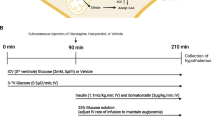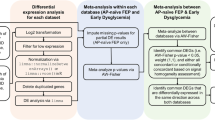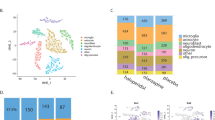Abstract
Clozapine is an atypical antipsychotic drug with unique pharmacological and therapeutic properties. Unlike the typical antipsychotic drug, haloperidol, clozapine does not cause extrapyramidal side effects; however, weight gain, dyslipidemia, and type II diabetes are commonly associated with the use of this drug in subjects with schizophrenia. The aim of this study was to profile gene expression in the rat striatum following clozapine treatment. Chronic treatment with clozapine revealed upregulation of several genes including the glucose-dependent insulinotropic polypeptide (GIP) gene by over 200% in the rat striatum. The cDNA array results for the GIP gene were confirmed by real-time RT-PCR as well as by radioimmunoassay. Expression of the GIP gene in the central nervous system is consistent with the results of retinal GIP gene expression as reported by other investigators. Taken together, these findings implicate the possible role of GIP as a neuromodulator in the central nervous system. GIP is an insulinotropic agent with stimulatory effects on insulin synthesis and release from the pancreas. However, changes in brain GIP levels are most likely unrelated to the metabolic adverse effects (dyslipidemia, type II diabetes, weight gain) associated with clozapine treatment. Therefore, we also measured GIP gene expression in the K-cell-rich regions, duodenum and jejunum (small intestine), and plasma GIP levels using radioimmunoassay following chronic treatment with clozapine. GIP mRNA levels in the small intestine and the plasma GIP at the protein level were significantly elevated in clozapine-treated subjects. Furthermore, as observed in humans, chronic clozapine treatment also caused weight gain, and increased levels of insulin, triglycerides and leptin in the plasma. These results suggest that adverse metabolic effects associated with clozapine treatment may be related to its ability to increase intestinal gene expression for GIP.
This is a preview of subscription content, access via your institution
Access options
Subscribe to this journal
Receive 6 print issues and online access
$259.00 per year
only $43.17 per issue
Buy this article
- Purchase on Springer Link
- Instant access to full article PDF
Prices may be subject to local taxes which are calculated during checkout







Similar content being viewed by others
Abbreviations
- 5-HT :
-
serotonin
- cAMP :
-
cyclic adenosine monophosphate
- CRE :
-
cAMP response element
- CREB :
-
cAMP response element-binding protein
- GIP :
-
glucose-dependent insulinotropic polypeptide
- GLUT4 :
-
glucose transporter-4
- MMLV :
-
Moloney Murine Leukemia Virus
- PKA :
-
protein kinase A
- RT-PCR :
-
reverse transcriptase-polymerase chain reaction
References
Cho GJ, Ryu S, Kim YH, Kim YS, Cheon EW, Park JM et al. Upregulation of glucose-dependent insulinotropic polypeptide and its receptor in the retina of streptozotocin-induced diabetic rats. Curr Eye Res 2002; 25: 381–388.
Leucht S, Pitschel-Walz G, Abraham D, Kissling W . Efficacy and extrapyramidal side-effects of the new antipsychotics olanzapine, quetiapine, risperidone, and sertindole compared to conventional antipsychotics and placebo. A meta-analysis of randomized controlled trials. Schizophr Res 1999; 35: 51–68.
Pickar D . Prospects for pharmacotherapy of schizophrenia. Lancet 1995; 345: 557–562.
Pilowsky LS, Costa DC, Ell PJ, Murray RM, Verhoeff NP, Kerwin RW . Clozapine, single photon emission tomography, and the D2 dopamine receptor blockade hypothesis of schizophrenia. Lancet 1992; 340: 199–202.
Richelson E, Nelson A . Antagonism by neuroleptics of neurotransmitter receptors of normal human brain in vitro. Eur J Pharmacol 1984; 103: 197–204.
Tauscher J, Hussain T, Agid O, Verhoeff NP, Wilson AA, Houle S et al. Equivalent occupancy of dopamine D1 and D2 receptors with clozapine: differentiation from other atypical antipsychotics. Am J Psychiatry 2004; 161: 1620–1625.
Newcomer JW . Abnormalities of glucose metabolism associated with atypical antipsychotic drugs. J Clin Psychiatry 2004; 65: Suppl 18: 36-46.
Buchanan RW . Clozapine: efficacy and safety. Schizophr Bull 1995; 21: 579–591.
McGurk SR . The effects of clozapine on cognitive functioning in schizophrenia. J Clin Psychiatry 1999; 60 (Suppl 12): 24–29.
Meltzer HY, Okayli G . Reduction of suicidality during clozapine treatment of neuroleptic-resistant schizophrenia: impact on risk-benefit assessment. Am J Psychiatry 1995; 152: 183–190.
Gianfrancesco F, White R, Wang RH, Nasrallah HA . Antipsychotic-induced type 2 diabetes: evidence from a large health plan database. J Clin Psychopharmacol 2003; 23: 328–335.
Hagg S, Joelsson L, Mjorndal T, Spigset O, Oja G, Dahlqvist R . Prevalence of diabetes and impaired glucose tolerance in patients treated with clozapine compared with patients treated with conventional depot neuroleptic medications. J Clin Psychiatry 1998; 59: 294–299.
Henderson DC, Cagliero E, Gray C, Nasrallah RA, Hayden DL, Schoenfeld DA et al. Clozapine, diabetes mellitus, weight gain, and lipid abnormalities: a five-year naturalistic study. Am J Psychiatry 2000; 157: 975–981.
Henderson DC . Atypical antipsychotic-induced diabetes mellitus: how strong is the evidence? CNS Drugs 2002; 16: 77–89.
Melkersson KI, Hulting AL, Brismar KE . Different influences of classical antipsychotics and clozapine on glucose-insulin homeostasis in patients with schizophrenia or related psychoses. J Clin Psychiatry 1999; 60: 783–791.
Popli AP, Konicki PE, Jurjus GJ, Fuller MA, Jaskiw GE . Clozapine and associated diabetes mellitus. J Clin Psychiatry 1997; 58: 108–111.
Wirshing DA, Spellberg BJ, Erhart SM, Marder SR, Wirshing WC . Novel antipsychotics and new onset diabetes. Biol Psychiatry 1998; 44: 778–783.
Yazici KM, Erbas T, Yazici AH . The effect of clozapine on glucose metabolism. Exp Clin Endocrinol Diabetes 1998; 106: 475–477.
Sernyak MJ, Leslie DL, Alarcon RD, Losonczy MF, Rosenheck R . Association of diabetes mellitus with use of atypical neuroleptics in the treatment of schizophrenia. Am J Psychiatry 2002; 159: 561–566.
Casey DE . Dyslipidemia and atypical antipsychotic drugs. J Clin Psychiatry 2004; 65 (Suppl 18): 27–35.
Howes OD, Bhatnagar A, Gaughran FP, Amiel SA, Murray RM, Pilowsky LS . A prospective study of impairment in glucose control caused by clozapine without changes in insulin resistance. Am J Psychiatry 2004; 161: 361–363.
Henderson DC, Cagliero E, Copeland PM, Borba CP, Evins E, Hayden D et al. Glucose metabolism in patients with schizophrenia treated with atypical antipsychotic agents: a frequently sampled intravenous glucose tolerance test and minimal model analysis. Arch Gen Psychiatry 2005; 62: 19–28.
Henderson DC . Clozapine: diabetes mellitus, weight gain, and lipid abnormalities. J Clin Psychiatry 2001; 62 (Suppl 23): 39–44.
Dwyer DS, Donohoe D . Induction of hyperglycemia in mice with atypical antipsychotic drugs that inhibit glucose uptake. Pharmacol Biochem Behav 2003; 75: 255–260.
Bridler R, Umbricht D . Atypical antipsychotics in the treatment of schizophrenia. Swiss Med Wkly 2003; 133: 63–76.
Centorrino F, Fogarty KV, Cimbolli P, Salvatore P, Thompson TA, Sani G et al. Aripiprazole: initial clinical experience with 142 hospitalized psychiatric patients. J Psychiatr Pract 2005; 11: 241–247.
Naber D, Lambert M . Aripiprazole: a new atypical antipsychotic with a different pharmacological mechanism. Prog Neuropsychopharmacol Biol Psychiatry 2004; 28: 1213–1219.
Sondhi S, Thomas N, Chong VZ, N-Marandi S, Castellano JM, Gabriele J et al. Glucose-Dependent Insulinotropic polypeptide (GIP) and its receptors: gene expression in discrete human brain regions. Abstract: Society for Neuroscience 2003.
Sondhi S, Thomas N, Castellano J, N-Marandi S, Gabriele J, Chong V et al. Glucose-dependent insulinotropic polypeptide and its receptors: gene expression in discrete human brain regions. FASEB J 2004; 19: 3011.
Usdin TB, Mezey E, Button DC, Brownstein MJ, Bonner TI . Gastric inhibitory polypeptide receptor, a member of the secretin-vasoactive intestinal peptide receptor family, is widely distributed in peripheral organs and the brain. Endocrinology 1993; 133: 2861–2870.
Kaplan AM, Vigna SR . Gastric inhibitory polypeptide (GIP) binding sites in rat brain. Peptides 1994; 15: 297–302.
Alvarez E, Martinez MD, Roncero I, Chowen JA, Garcia-Cuartero B, Gispert JD et al. The expression of GLP-1 receptor mRNA and protein allows the effect of GLP-1 on glucose metabolism in the human hypothalamus and brainstem. J Neurochem 2005; 92: 798–806.
Creutzfeldt W . The incretin concept today. Diabetologia 1979; 16: 75–85.
Fehmann HC, Goke R, Goke B . Cell and molecular biology of the incretin hormones glucagon-like peptide-I and glucose-dependent insulin releasing polypeptide. Endocr Rev 1995; 16: 390–410.
Higashimoto Y, Opara EC, Liddle RA . Dietary regulation of glucose-dependent insulinotropic peptide (GIP) gene expression in rat small intestine. Comp Biochem Physiol C Pharmacol Toxicol Endocrinol 1995; 110: 207–214.
Meier JJ, Nauck MA, Schmidt WE, Gallwitz B . Gastric inhibitory polypeptide: the neglected incretin revisited. Regul Pept 2002; 107: 1–13.
Morgan LM . The metabolic role of GIP: physiology and pathology. Biochem Soc Trans 1996; 24: 585–591.
Yip RG, Wolfe MM . GIP biology and fat metabolism. Life Sci 2000; 66: 91–103.
Cataland S, Crockett SE, Brown JC, Mazzaferri EL . Gastric inhibitory polypeptide (GIP) stimulation by oral glucose in man. J Clin Endocrinol Metab 1974; 39: 223–228.
Pederson RA, Schubert HE, Brown JC . Gastric inhibitory polypeptide. Its physiologic release and insulinotropic action in the dog. Diabetes 1975; 24: 1050–1056.
Buchan AM, Polak JM, Capella C, Solcia E, Pearse AG . Electronimmunocytochemical evidence for the K cell localization of gastric inhibitory polypeptide (GIP) in man. Histochemistry 1978; 56: 37–44.
Gremlich S, Porret A, Hani EH, Cherif D, Vionnet N, Froguel P et al. Cloning, functional expression, and chromosomal localization of the human pancreatic islet glucose-dependent insulinotropic polypeptide receptor. Diabetes 1995; 44: 1202–1208.
Thomas FB, Shook DF, O'Dorisio TM, Cataland S, Mekhjian HS, Caldwell JH et al. Localization of gastric inhibitory polypeptide release by intestinal glucose perfusion in man. Gastroenterology 1977; 72: 49–54.
Volz A, Goke R, Lankat-Buttgereit B, Fehmann HC, Bode HP, Goke B . Molecular cloning, functional expression, and signal transduction of the GIP-receptor cloned from a human insulinoma. FEBS Lett 1995; 373: 23–29.
Wheeler MB, Gelling RW, McIntosh CH, Georgiou J, Brown JC, Pederson RA . Functional expression of the rat pancreatic islet glucose-dependent insulinotropic polypeptide receptor: ligand binding and intracellular signaling properties. Endocrinology 1995; 136: 4629–4639.
Ding WG, Gromada J . Protein kinase A-dependent stimulation of exocytosis in mouse pancreatic beta-cells by glucose-dependent insulinotropic polypeptide. Diabetes 1997; 46: 615–621.
Lu M, Wheeler MB, Leng XH, Boyd III AE . The role of the free cytosolic calcium level in beta-cell signal transduction by gastric inhibitory polypeptide and glucagon-like peptide I(7-37). Endocrinology 1993; 132: 94–100.
Jones IR, Owens DR, Luzio S, Hayes TM . Glucose dependent insulinotropic polypeptide (GIP) infused intravenously is insulinotropic in the fasting state in type 2 (non-insulin dependent) diabetes mellitus. Horm Metab Res 1989; 21: 23–26.
Ross SA, Brown JC, Dupre J . Hypersecretion of gastric inhibitory polypeptide following oral glucose in diabetes mellitus. Diabetes 1977; 26: 525–529.
Theodorakis MJ, Carlson O, Muller DC, Egan JM . Elevated plasma glucose-dependent insulinotropic polypeptide associates with hyperinsulinemia in impaired glucose tolerance. Diabetes Care 2004; 27: 1692–1698.
Atmaca M, Kuloglu M, Tezcan E, Ustundag B . Serum leptin and triglyceride levels in patients on treatment with atypical antipsychotics. J Clin Psychiatry 2003; 64: 598–604.
Melkersson KI, Dahl ML . Relationship between levels of insulin or triglycerides and serum concentrations of the atypical antipsychotics clozapine and olanzapine in patients on treatment with therapeutic doses. Psychopharmacology 2003; 170: 157–166.
Salera M, Ebert R, Giacomoni P, Pironi L, Venturi S, Corinaldesi R et al. Adrenergic modulation of gastric inhibitory polypeptide secretion in man. Dig Dis Sci 1982; 27: 794–800.
Aantaa R, Marjamaki A, Scheinin M . Molecular pharmacology of alpha 2-adrenoceptor subtypes. Ann Med 1995; 27: 439–449.
Inagaki N, Seino Y, Takeda J, Yano H, Yamada Y, Bell GI et al. Gastric inhibitory polypeptide: structure and chromosomal localization of the human gene. Mol Endocrinol 1989; 3: 1014–1021.
Someya Y, Inagaki N, Maekawa T, Seino Y, Ishii S . Two 3′,5′-cyclic-adenosine monophosphate response elements in the promoter region of the human gastric inhibitory polypeptide gene. FEBS Lett 1993; 317: 67–73.
Leucht S, Wahlbeck K, Hamann J, Kissling W . New generation antipsychotics versus low-potency conventional antipsychotics: a systematic review and meta-analysis. Lancet 2003; 361: 1581–1589.
Kapur S, VanderSpek SC, Brownlee BA, Nobrega JN . Antipsychotic dosing in preclinical models is often unrepresentative of the clinical condition: a suggested solution based on in vivo occupancy. J Pharmacol Exp Ther 2003; 305: 625–631.
Chong VZ, Young LT, Mishra RK . cDNA array reveals differential gene expression following chronic neuroleptic administration: implications of synapsin II in haloperidol treatment. J Neurochem 2002; 82: 1533–1539.
Goto A, Doering L, Nair VD, Mishra RK . Immunohistochemical localization of a 40-kDa catecholamine regulated protein in the nigrostriatal pathway. Brain Res 2001; 900: 314–319.
Acknowledgements
This work was supported by the Ontario Mental Health Foundation and National Institute of Health Grant NS20035 and the Canadian Institute of Health Research Grant MT2637.
Author information
Authors and Affiliations
Corresponding author
Additional information
Contacts: S Sondhi – shireen_sondhi@hotmail.com; JM Castellano – castej@mcmaster.ca; VZ Chong – chongv@mcmaster.ca; RM Rogoza – rainar@hotmail.com; KJ Skoblenick – skoblek@mcmaster.ca; BA Dyck – dyckba@mcmaster.ca; J Gabriele – gabriejp@mcmaster.ca; N Thomas – nthomas@mcmaster.ca; ZB Pristupa – z.pristupa@utoronto.ca; AN Singh – singha@post.queensu.ca; D MacCrimmon – maccrim@mcmaster.ca; P Voruganti – vorugl@mcmaster.ca; J Foster – jfoster@mcmaster.ca.
Preliminary results of this study were reported at the annual meeting of the Society for Neuroscience, 2003, San Diego CA, USA and at the Federation for American Societies of Experimental Biology Meeting in 2004, Washington, DC.
Rights and permissions
About this article
Cite this article
Sondhi, S., Castellano, J., Chong, V. et al. cDNA array reveals increased expression of glucose-dependent insulinotropic polypeptide following chronic clozapine treatment: role in atypical antipsychotic drug-induced adverse metabolic effects. Pharmacogenomics J 6, 131–140 (2006). https://doi.org/10.1038/sj.tpj.6500346
Received:
Revised:
Accepted:
Published:
Issue Date:
DOI: https://doi.org/10.1038/sj.tpj.6500346
Keywords
This article is cited by
-
Tirzepatide prevents neurodegeneration through multiple molecular pathways
Journal of Translational Medicine (2024)
-
Association between the GIPR gene and the insulin level after glucose loading in schizophrenia patients treated with olanzapine
The Pharmacogenomics Journal (2012)
-
Cocainomics: New Insights into the Molecular Basis of Cocaine Addiction
Journal of Neuroimmune Pharmacology (2010)
-
Pharmacogenetics and pharmacogenomics of schizophrenia: a review of last decade of research
Molecular Psychiatry (2007)



